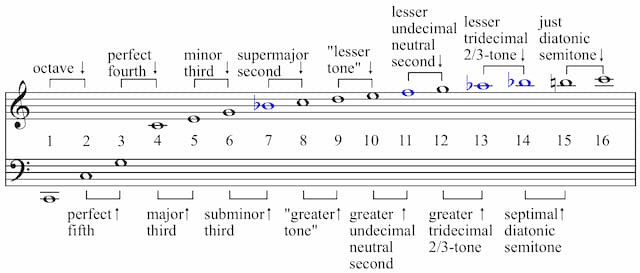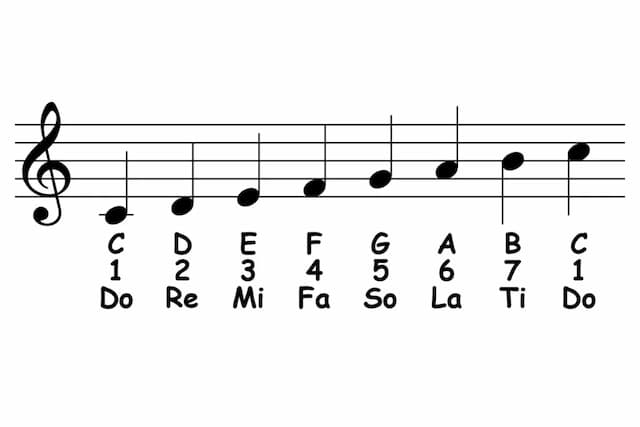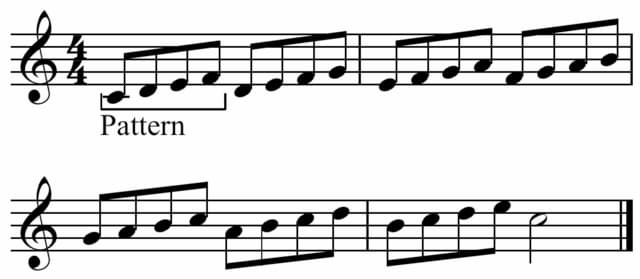Melodic Dictation & Ear Training - How to Practice Melodic Dictation?

Mastering melodic dictation is one of the greatest challenges faced by many music students. It is a difficult skill to master, requiring the interplay of many sub-skills and cognitive processes. Even if you are not a music student in a college or high school course, learning how to do melodic dictation can vastly improve your musicality.
Unfortunately, many students don’t know how to study melodic dictation effectively. They end up relying on unhelpful and ineffective methods like interval-based thinking and trial-and-error approaches to get them through.
In this article, we’ll look at why these methods are unhelpful, and how you can employ better techniques to become a melodic dictation whiz!
What is Melodic Dictation?
Melodic dictation is the practice of listening to and transcribing a melody by ear. This means you hear some notes (usually on a piano) and are able to identify what has been played. Usually, prior to playing the melody, the tonality will be established, either by playing the major scale in the key that the melody will be in, or by playing a chord progression in the key that clearly establishes the tonal center (such as I IV V I, or IV V I).
Examples of Melodic Dictation
Melodic dictation can be very simple or very complex. When first starting out, you may only hear a few notes, played very slowly (Do Re Mi Re Do, for example). Another common technique in melodic dictation is to play arpeggiated chords.
Here is an example of a very easy melodic dictation exercise.
Why is Melodic Dictation So Important in Ear Training?
Melodic dictation is a huge part of musical training in high school and college courses. However, it is also a great skill for casual musicians to learn. Why? Because when done in an effective way, it helps build and strengthen the cognitive processes involved in recognizing melodies in real music.
By familiarizing yourself with melodic lines and patterns, you’ll begin to be able to identify melodies quickly and intuitively when playing and listening to music. You’ll be able to recognize and reproduce pitches without thinking about it. This will open up your musical creativity and tremendously expand your musical freedom when performing, improvising, and composing.

Strategies for Melodic Dictation
As mentioned at the top of this article, there are effective strategies to practice melodic dictation, and there are totally ineffective strategies. Melodic dictation for beginners can be a minefield if you don’t know which methods are good and which are bad.
So how will you know how to get better at melodic dictation? Let’s first take a look at the ineffective ways of practicing melodic dictation.
Relying on an Instrument
Melodic dictation should be done entirely by ear. Yes, you will hear the melody played on an instrument, but you should not attempt to reproduce the pitches on your own instrument before identifying them. This defeats the whole purpose of the dictation.
If you need to sing the melody to yourself before writing it down, that’s fine, because in this case, the pitches are still coming from inside you. You are still using your inner ear to audiate the pitches. Indeed, singing is actually very important initially and we absolutely recommend it to our students.
Attempting to find the pitches yourself on a keyboard or other instrument in between hearing them and writing them down will make you wholly dependent on your instrument to find pitches in the future, and will not allow you to develop your ear training skills nor your musicality.

Interval-Based Thinking
The next big mistake people make when approaching melodic dictation practice is to adopt an interval-based cognitive process. This means attempting to isolate and identify intervals (major third, perfect fifth, minor sixth, etc.) within the melody.
Not only is this an incredibly slow and frustrating process, it also prevents you from hearing how the pitches function within the tonality as a whole. If you are not internalizing the sonic sensation of each note within the key, you will not be able to quickly identify an entire line (for example, Do Re Mi Fa Sol), or intuitively hear large jumps (for example, from Do to Ti).
There are many scientific studies showing exactly why interval-based exercises won’t improve your melodic dictation skills; quite the contrary, they will hinder your progress.
Now that we know what not to do, let’s take a look at some more effective methods for melodic dictation.

How do You Master Melodic Dictation?
There are a number of sub-skills needed in order to be successful at melodic dictation. Those include short-term musical memory, tonic retention (remembering where Do is), note analysis (recognizing the sonic sensation and function of a particular note in the tonality), and others.
Most students are good at some skills and not others. It’s important to focus on improving your weak areas, rather than only relying on your strengths to get you through. Following a tonal, step-by-step method for ear training will help you improve on all of the sub-skills necessary for melodic dictation.

Melodic Dictation Practice - What to Focus On?
There are three main mechanisms for recognizing notes in a melody. Those are:
- recognizing the note by thinking of the scale
- recognizing the color of the note within the key
- recognizing multiple notes at once by referring to familiar patterns
Let’s take a look at each mechanism.
Thinking of the Scale
The first cognitive mechanism for recognizing melodies is to determine the scale degree of each note by relating it to the scale. First, you must be able to hear and sing the scale. It can help to sing the whole scale out loud, both up and down.
Once you know the scale in which the melody is played, use your voice to match the notes in the melody to specific degrees of the scale. Do this out loud at first (it’s easier than doing it in your head) and use solfeggio. Solfeggio syllables will give you a very clear understanding of which note is which within the scale.

Recognizing the “Color” of the Note Within the Key
The next method for recognizing notes in a melody is to understand the color or sonic sensation that the note assumes within the tonality. Every note within a scale has a certain ‘feel’ or color. For example, Ti (the seventh scale degree) has a very unstable sound because it wants to resolve to Do. Do, on the contrary, sounds very stable, indeed it’s the first degree of the key and it’s the most stable note.
Once you start to recognize the unstable sound of Ti, you will quickly be able to identify it or imagine it in your head out of nowhere, after the tonality has been established. Not only that, you will be able to do the same with any other degree of the scale (and also notes outside the scale - this is more advanced though!)
Rather than thinking of isolated intervals (like “That was a half step”) you will start to think in terms of sonic sensation (“That was a very unstable note that resolved upward to the tonic, it must have been Ti-Do”). With time and enough repetition, these cognitive process will become automatic and intuitive and you won’t need to think anymore. You will recognize notes (and also chords) immediately, like you recognize visual colors.
Recognizing Patterns
The most powerful cognitive mechanism for identifying melodies is pattern recognition. This is where hearing the scale, knowing solfeggio, and recognizing tonal colors come together to blow interval-based thinking out of the water.
Eventually, you will be able to relate whole melodic lines that you hear to higher-order patterns like scales, arpeggiated chords, or even chunks of other melodies you already know. At this point, your melodic recognition skills will be so swift and intuitive they will feel innate. You will be able to recognize patterns of multiple notes immediately, without even thinking about it. This simply cannot be achieved with interval-based exercises.

How to Practice Melodic Dictation Exercises Correctly?
When practicing melodic dictation, it’s important to do it right to make sure you’re building all the necessary sub-skills. Take a tonal approach as opposed to thinking in isolated intervals. Root yourself in tonality, and start at the appropriate level (not too hard, not too easy). Read on for some strategies for melodic dictation and tips on how to implement these suggestions.
Melodic Dictation Tips - How to Get Better at Melodic Dictation
So how can you make sure you are practicing your melodic dictation exercises correctly? If you’re wondering how to improve melodic dictation, here are a few melodic dictation tips to make sure your practice is successful.
- Start small. Begin with four notes or less at a time so you don’t overwhelm your short-term musical memory.
- Increase the difficulty step by step. Pick one new thing to practice at a time. (For example, practice faster melodies or longer melodic lines, not both at once!)
- Ground yourself in tonality before you start. Play the scale, or play a I IV V I chord progression to get your ear rooted in the key of the melody.
- Sing the scale out loud if you need to in order to find the pitches within it.
- Avoid interval-based thinking; always rely on thinking in terms of tonality and scale degrees instead.
- Do not rely on an instrument to reproduce the pitches for you before you have sung or transcribed them yourself.
- Identify the issue that’s holding you back the most and work only on that specific aspect. For example, if you have issues in retaining the melody (you often forget the notes), it’s beneficial to work specifically on improving your short-term musical memory. Whereas if you can retain a melody easily but you find it hard to identify the notes, then it’s a symptom that you need to level up your note analysis and recognition skills. We have created an ear training approach designed with all of these strategies in mind.
Read on to learn how Use Your Ear can help you with melodic dictation practice through our science-based, step-by-step method.
The Most Effective Ear Training Method for Melodic Dictation
The Use Your Ear method is different from any other ear training methods. Rather than focusing on isolated intervals and other ineffective methods, we take a scientific, step-by-step approach to melody ear training and ear training in general that our students have found extremely successful even when other methods have failed them.
Our methods are one hundred percent tonal-based and incremental. You’ll get lots of practice hearing and identifying melodic lines, as well as practice with solfeggio, and you’ll start at the level appropriate for you and build from there.
If you’re interested in learning more about our method, plus getting some completely free instruction and exercises to practice on your own, check out our free Use Your Ear workshop. This workshop will help you evaluate your current level and give you clear instructions on how to proceed based on that.
It will also show you all the scientific findings that are at the core of the Use Your Ear method, giving you the knowledge to setup an effective ear training routine and avoid ineffective exercises. You’ll come away with free exercises to use in your own practice - no strings attached!
If you’re looking for something more in-depth, take a look at our relative pitch video course. This is a full program that has helped thousands of students see noticeable and consistent results that really transformed their musicality.It’s the only science-based, completely step-by-step method available to help you master ear training, understand musical pitch, and develop a great inner sense of musicality.
You’ll practice step-by-step melodic dictation exercises (and many others) that will guide you to intuitively recognize and transcribe melodies and chord progressions, and you will be able to apply your new skills to real-life musical situations: music lessons, theory classes, jazz jams, choir practice, songwriting, arranging, exams, auditions, etc.
If you’d like a one-on-one atmosphere and want tailored feedback or on-demand assistance with specific problems, we can also help with that! Our one-on-one lessons pair you with a professional ear training instructor who is an expert in the Use Your Ear method. We provide lessons tailored specifically to your needs and skill level.

Conclusion
It’s never too late to start your ear training journey! Even if other methods have failed you in the past, our method will help you improve your melodic dictation skills, strengthen your inner ear, and finally become musically free and competent. Get in touch today to learn more!

